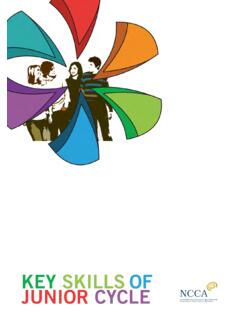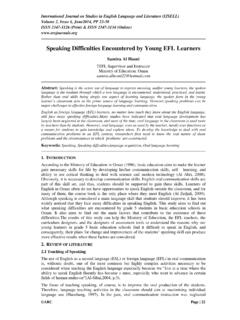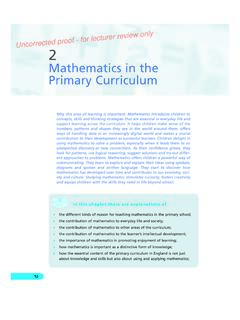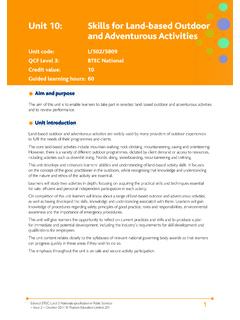Transcription of How to develop thinking and assessment for learning in …
1 How to develop thinking and assessment for learning in the classroom Guidance Guidance document No: 044/2010. Date of revision: November 2010. How to develop thinking and assessment for learning in the classroom Audience Teachers and senior managers in primary and secondary schools, further education colleges; local authorities; tutors in initial teacher training; and others with an interest in education. The booklet is essential for those practitioners involved in the development programme for thinking and assessment for learning . Overview This booklet is part of a series of guidance materials to support practitioners in implementing higher-quality teaching and learning by focusing on developing thinking and assessment for learning .
2 Action Schools' senior managers and local authority advisers are requested required to raise awareness of these resources within their schools, and to encourage teachers to use the materials to support their focus on quality teaching and learning . Further Enquiries about this document should be directed to: information Curriculum Division Department for Children, Education, Lifelong learning and Skills Welsh Assembly Government Cathays Park Cardiff CF10 3NQ. Tel: 029 2080 1243. e-mail: Additional This document can be accessed from the Welsh Assembly copies Government website at Related Why develop thinking and assessment for learning in the documents classroom? (Welsh Assembly Government, 2010). developing thinking and assessment for learning programme leaflet (Welsh Assembly Government, 2009).
3 developing thinking and assessment for learning poster (Welsh Assembly Government, 2007). WAG10-10789. ISBN: 978 0 7504 5861 0. Crown copyright 2010. Contents page 1. Introduction 4. 2. Group work 5. Why develop quality group work? 5. What is quality group work? 6. Task setting 6. Group size 7. Deciding on the makeup of the group 7. Ground rules 8. Deciding on roles 9. Using random feedback 11. Dealing with issues 12. 3. Questioning 15. 4. Managing metacognition 19. 5. developing thinking principles 21. Challenge 22. developing thinking principles to trial 23. Planning for opportunities to develop thinking 24. 6. assessment for learning principles 24. Questioning technique 24. Providing feedback to learners 25. Peer and self- assessment 26.
4 Ensuring learners are aware of the criteria 27. Progression in the use of success criteria 27. assessment for learning principles to trial 29. Planning for opportunities to use assessment for 29. learning 7. Planning for developing thinking and assessment for 30. learning 8. Overview of principles to trial 31. 9. Using the tools and strategies 32. developing thinking 32. assessment for learning 35. 10. Tools and strategies 36. Annexes 1. Teachers' checklists for group work 90. 2. developing thinking section of the skills framework 92. 3. Useful references 95. 4. Acknowledgements 96.. 1. Introduction This document attempts to draw together successful and popular teaching strategies/tools that have been used in the classroom to develop better quality thinking and assessment for learning .
5 In the document Why develop thinking skills and assessment for learning ?, Welsh Assembly Government, 2010, a number of parallels were drawn between both initiatives. In essence, the two are inextricably linked. It follows, therefore, that similar teaching tools may be used to stimulate better quality thinking and assessment for learning . However, as both developing thinking and assessment for learning also retain several specific characteristics as shown in the earlier document, it is important for teachers to be clear why any particular teaching tool or strategy is used, and how it fits with the underlying principles of developing thinking and/or assessment for learning . This document separates the two approaches when discussing principles, but the suggested tools and strategies have been brought into a single alphabetical list for ease of reference.
6 These are cross-referenced to the area of developing thinking or assessment for learning that they can potentially develop . Teachers in the development programme are asked to select three principles (see page 9) to trial in the classroom. The principles selected could all be from developing thinking or all from assessment for learning or a mixture of both. Teachers could try to develop these principles with one or more of their classes.. 2. Group work One of the overriding features of improving the quality of thinking and developing assessment for learning is the importance of establishing effective group work in the classroom. For the experiences to be conducive to learning , establishing the right kind of classroom climate is imperative.
7 Learners will need to be coached in (and frequently reminded of) their expected behaviour, with basic rules for interaction agreed beforehand. Some basic principles of developing a classroom climate for effective learning are: All contributions are valued No learners are excluded Learners feel safe to be creative and take risks in learning Co-operation, collaboration and respect for fellow learners are paramount. One of the most powerful tools in promoting these values is teacher-modelling. If learners witness teachers actively promoting these values, then they are more likely to embrace them. Why develop quality group work? Constructivism is the label given to a set of theories about learning . If behaviourism treats the organism as a black box, cognitive theory recognises the importance of the mind in making sense of the material with which it is presented.
8 Constructivism, particularly in its social' forms, suggests that the learner is much more actively involved in a joint enterprise with peers/the teacher of constructing new meanings. Vygotsky (1896-1934) observed that when children were set tasks on their own, they rarely did as well as when they were working in collaboration with a peer or an adult. It was by no means always the case that the adult/peer was teaching them how to perform the task, but that the process of engagement enabled them to refine their thinking or their performance to make it more effective. Hence, for him, the development of language and articulation of ideas was central to learning and development. He developed one of the most significant bases of social constructivist theory in his work on the zone of proximal development' (ZPD), where proximal' simply means next'.
9 It is common to differentiate learners into cannot yet do', can do with help', and can do alone'. The ZPD is about can do with help', not as a permanent state but as a stage towards being able to do something on your own. The key to stretching' the learner is to know what is in that learner's ZPD - what comes next, for them; in other words their next steps. The common-sense idea which fits most closely with this model is that of stretching' learners. Other, more recent, research has added to Vygotsky's theories with conclusions such as: Nearly 80% of what children learn, they learn from each other. Quality collaborative work ensures all learners are involved (inclusive).. Collaboration ensures better quality outcomes for all. Very often teachers are reluctant to use small group discussion in the classroom because they think it may lead to a lack of focus on the task.
10 On the other hand, research suggests that small group talk often stimulates and ensures real understanding. One particularly valuable feature of small group talk is exploratory talk. A learner may not have a fully formed idea, but in the process of trying to articulate their thoughts, their own (and other learners') ideas are clarified. Purpose The first requirement is to decide the purpose of the discussion, such as: problem-solving ( thinking about cause and effect and making inferences) . a sequencing activity discussion (considering evidence, information and ideas) a controversial topic production (forming opinions and making decisions) collaborating to write a text. When participating in small group discussions, some learners may rigorously stick to their own opinions, without listening to others.

















